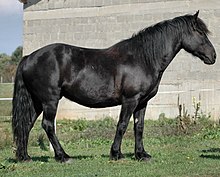Ariegeois pony

A Mérens horse
|
|
| Other names | Ariégeois pony, Cheval de Mérens |
|---|---|
| Country of origin | France (Ariège), Spain (Ariégeois mountains) |
| Breed standards | |
The Mérens or Cheval de Mérens, still occasionally referred to by the older name of Ariégeois pony, is a small, rustic horse native to the Pyrenees and Ariégeois mountains of southern France, where the Ariège River flows, and northern Spain, near Andorra. Two general types, a small, light traditional mountain horse and a taller, sportier modern type, are found. Always black in color, Mérens must meet strict physical standards in order to be registered in the stud book. The breed is known for its sure-footedness on mountain terrain, as well as for its endurance, hardiness and docility. The French breed registry organizes regional offices, and partners with other national organizations in Europe to preserve and promote the breed. The organization enforces rigorous selection of breeding stock, with a goal of increasing quality in the breed. In the past, the Mérens was used for farm work, draft work and as pack horses. Today it is mainly used as a saddle horse, although some members of the breed have been successful in carriage driving. Many Mérens are taken on an annual transhumance (seasonal migration), in which they are moved higher in the mountains during the summer and into the valleys for the winter. An old practice, it fell into disfavor, but has recently re-emerged.
Thought to have originated in prehistoric times, the exact early history of the Mérens remains a mystery. Theories on its origins include descent from Iberian horses, similar to many regional mountain horses, or possibly Oriental horses brought to the area by settlers from the east. Small black horses from the area of Ariège have been recorded as early as the time of Julius Caesar, as well as being associated with Charlemagne. They pulled artillery for Napoleon's Grand Army, as well as being used by farmers, dock workers, miners and smugglers moving goods through the Pyrenees mountains. They were frequently seen at local horse fairs, and were used to breed mules in a cross with Catalan donkeys. By the end of the 19th century, they had gained a reputation as light cavalry horses. At the same time, however, uncontrolled crossbreeding led to a decline in the purebred population, and in 1908 the local agricultural society was put in charge of the breed. The breed registry was created in 1933, and in 1948 the first stud book was created under the control of the French National Stud.
...
Wikipedia
